
Dinghy sailing is the activity of sailing small boats by using five essential controls:
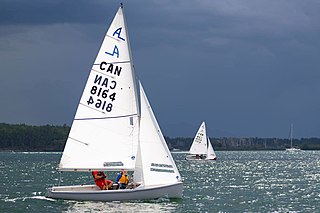
The Albacore is a 4.57 m (15 ft) two-person planing dinghy with fractional sloop rig, for competitive racing and lake and near-inshore day sailing. Hulls are made of either wood or fiberglass. The basic shape was developed in 1954 from an Uffa Fox design, the Swordfish. Recent boats retain the same classic dimensions, and use modern materials and modern control systems.

The Laser is a class of single-handed, one-design sailing dinghies using a common hull design with three interchangeable rigs of different sail areas, appropriate to a given combination of wind strength and crew weight. Ian Bruce and Bruce Kirby designed the Laser in 1970 with an emphasis on simplicity and performance.

The 470 (Four-Seventy) is a double-handed monohull planing dinghy with a centreboard, Bermuda rig, and centre sheeting. Equipped with a spinnaker, trapeze and a large sail-area-to-weight ratio, it is designed to plane easily, and good teamwork is necessary to sail it well. The name comes from the boat's length of 470 centimetres.
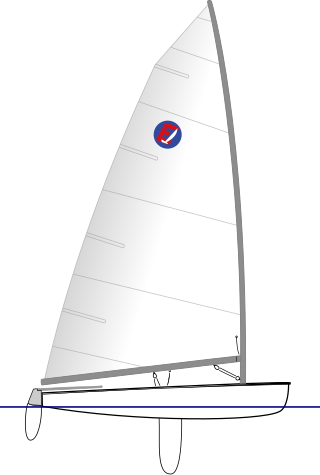
The Europe is a one-person dinghy designed in Belgium in 1960 by Alois Roland as a class legal Moth dinghy. The design later changed into its own one-design class.
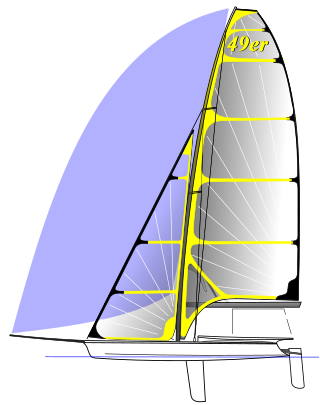
The 49er and 49er FX is a two-handed skiff-type high-performance sailing dinghy. The two crew work on different roles with the helm making many tactical decisions, as well as steering, and the crew doing most of the sail control. Both of the crew are equipped with their own trapeze and sailing is done while cantilevered over the water to the fullest extent to balance against the sails.

The Laser 4.7 or ILCA 4 is a one-design dinghy class in the Laser series and is a one-design class of sailboat. All Lasers are built to the same specifications. The Laser is 4.06 m long, with a waterline length of 3.81 m. The hull weight is 59 kg (130 lb). The boat is manufactured by ILCA and World Sailing approved builders.
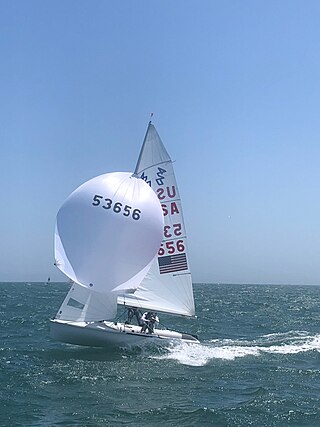
The International 420 Dinghy is a sailing dinghy popular for racing and teaching. The hull is fiberglass with internal buoyancy tanks. The 420 has a bermuda rig, spinnaker and trapeze. It has a large sail-area-to-weight ratio, and is designed to plane easily. The 420 is an International class recognised by World Sailing. The name refers to the boat's length of 420 centimetres.
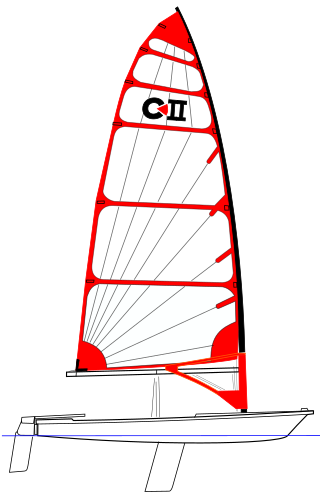
The Byte is a small one-design sailing dinghy sailed by one person. It was designed by Canadian Ian Bruce, who also commissioned and marketed the Laser.

The Firefly is a British sailboat that was designed by Uffa Fox as a one design racer and first built in 1946. The boat was originally named the Sea Swallow. It was an Olympic class and raced at the 1948 Olympics.

The Jet 14 is an American sailing dinghy that was designed by Howard Siddons as a one-design racer and first built in 1952.

The Tasar is a 14.83-foot (4.52 m) fiberglass 2 person sailing dinghy with a mainsail and jib. Designed by Frank Bethwaite of Sydney in 1975, the boat was technologically advanced for its time and continues to evolve. Aimed at a husband-and-wife or parent-and-child crew hence no spinnaker, it is designed for a combined crew weight of around 140 kg. The hull weighs 68 kg, and is of sandwich foam construction. The hull has a fine angle at the bow to reduce wave impact drag with unusually clean and sharp chines aft to ensure very free planing and outstanding stability. The foam cored hull is stiff and light and the advanced hull shape, together with an innovative rig which combines a rotating mast with a fully battened main sail, allows the Tasar to plane upwind with the crew normally hiked. The wide beam and a cockpit designed for comfortable hiking make the Tasar easy, fun and very exciting to sail in winds up to 25 knots (46 km/h).

The 18 ft Skiff is considered the fastest class of sailing skiffs. The class has a long history beginning with races on Sydney Harbour, Australia in 1892 and later in New Zealand. The boat has changed significantly since the early days, bringing in new technology as it became available. Because of the need of strength, agility and skill, the class is considered to be the top level of small boat sailing. Worldwide this boat is called the "18 Foot Skiff". It is the fastest conventional non-foiling monohull on the yardstick rating, with a score of 675, coming only third after the Tornado and Inter 20.

The International 14 is a British racing sailboat, crewed by two sailors. The class was established in 1928.

The Cherub is a 12 feet long, high performance, two-person, planing dinghy first designed in 1951 in New Zealand by John Spencer. The class is a development class, allowing for significant variation in design between different boats within the rule framework. The minimum hull weight was originally 110 lbs.

The Banshee, sometimes called the Banshee 13, is an American sailing dinghy that was designed by Richard L. Reid as a one-design racer and first built in 1969.

Gordon K. "Sandy" Douglass was an American racer, designer, and builder of sailing dinghies. Two of his designs, the Thistle and the Flying Scot, are among the most popular one design racing classes in the United States. The Flying Scot was inducted into the American Sailboat Hall of Fame. As a small boat racer, Douglass was five times the North American champion in the 10 Square Meter International Sailing Canoe, five times the United States national champion in the Thistle, and seven times the Flying Scot North American champion.

The Wētā 4.4 Trimaran is a 4.4 metre sailing dinghy conceived and developed in New Zealand from 2001-2006 by Roger and Chris Kitchen and others with original drawings by TC Design's Tim Clissold.
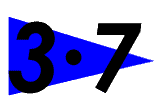
The Farr 3.7 is a one-person sailing dinghy designed by Bruce Farr in 1971. The design plans are sold by the 3.7 Class Owners Association and they are built by a mix of professionals and home built by amateurs. The 3.7 Class is recognised by Yachting New Zealand as a national class and yachts are sailed in New Zealand, Australia and Great Britain. Full sets of plans have been sold worldwide to a number of individuals with greatest numbers in Germany, Japan, USA, South Korea, Poland, France, Belgium, Russia, Spain, Uruguay.
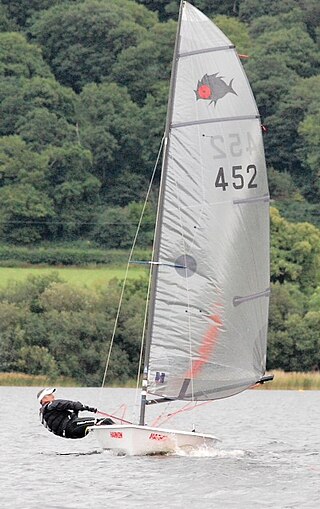
The Solution is a single handed hiking dinghy designed for helms in the 65 to 85 kg weight range. It has a light epoxy hull, self draining cockpit, high aspect rig, semi battened 8.5 sq. metre sail, and full complement of dual controls.























